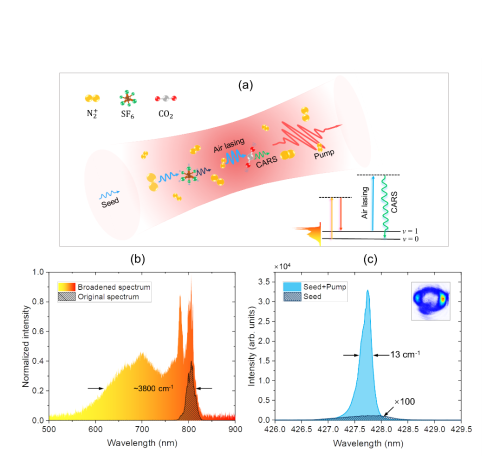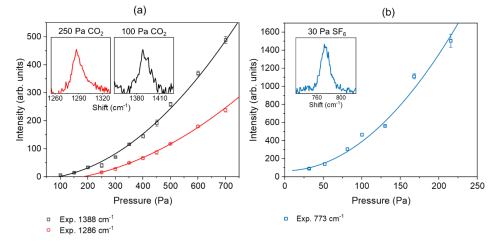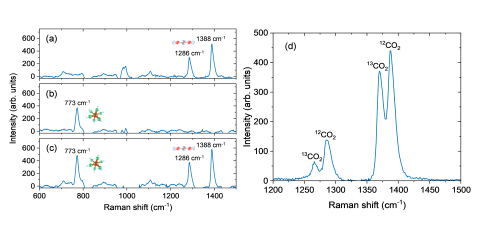The innovative advances in ultrafast laser technologies provide new strategies for remote sensing of atmospheric pollutants and hazardous biochemical agents owing to its unique advantages of high peak power, short pulse duration, broad spectral coverage, etc. On the one hand, the high-energy femtosecond laser can propagate a long distance without diffraction via femtosecond laser filamentation. On the other hand, abundant secondary radiations, e.g., supercontinuum white light, air lasing, fluorescence, provide natural probe sources for atmospheric detection at a remote location. Therefore, over the past 20 years, femtosecond-laser-based remote sensing attracts extensive interests.
Particularly, the discovery and intensive investigation of air lasing in recent years open an exciting perspective for atmospheric remote sensing due to its ability of generating cavity-free light amplification in the open air. Particularly, some unique properties (e.g., the narrow spectrum, natural spatial overlap with the femtosecond driver laser, intrinsic delay with respect to the driver laser, asymmetric temporal envelope, etc.) make it suitable as an ideal probe for atmospheric diagnosis. Although significant efforts have been paid to air-lasing-based remote sensing, the realistic application still remains challenging due to the limit of the detection sensitivity and signal stability.
Recently, the research team from Shanghai Institute of Optics and Fine Mechanics (SIOM) of the Chinese Academy of Sciences(CAS) proposed an air-lasing-assisted coherent Raman spectroscopy, realizing quantitative measurement and simultaneous detection of two greenhouse gases, as well as identification of CO2 isotopes. The detection sensitivity reaches the level of 0.03% and the minimum signal fluctuation is about 2%. The work has been published in Ultrafast Science on April 8, 2022.
The basic principle of air-lasing-assisted coherent Raman spectroscopy is shown in Fig. 1. The extremely nonlinear interaction of femtosecond laser with air molecules excites the optical gain of molecular nitrogen ions and achieves a seed amplification of more than 1,000 times, resulting in 428 nm air lasing with a linewidth of 13 cm-1. Meanwhile, the spectral width of the pump laser has reached 3800 cm-1 after nonlinear propagation, which is more than one order of magnitude broader than the spectrum of incident laser. It thus enables us to excite the molecular coherent vibrations of most pollutants and greenhouse gases. When air lasing encounters coherently vibrating molecules, it will effectively produce coherent Raman scattering. By recording the frequency difference of Raman signal and air lasing, namely “Raman fingerprint”, the molecular “identity information” can be known.
Air-lasing-assisted coherent Raman spectroscopy combines the advantages of femtosecond laser and air lasing. Femtosecond laser has a broad spectral coverage and a short pulse duration, which can excite coherent vibrations of many molecules at the same time. Air lasing has a narrow spectral width, enabling us to effectively distinguish the Raman fingerprints of different molecules. Therefore, this technique can meet the needs of multi-component measurement and chemical specificity.
To obtain a high detection sensitivity and signal stability, the research team from SIOM also adopted ingenious designs in their experiment, especially the optimization of pump-seed delay and the choice of perpendicular polarization. They measured the quantitative relationship between the Raman signal intensity of CO2 and SF6 mixed in air and corresponding gas concentrations. It was found that the minimum detectable concentrations of CO2 and SF6 can reach 0.1% and 0.03%, respectively, as shown in Fig. 2. The minimum signal fluctuation reached the level of 2%.
Furthermore, the researchers demonstrated that the technique can be applied for multi-component simultaneous measurement and distinguishing 12CO2 and 13CO2, as shown in Fig. 3. The simultaneous measurement of various pollutants and greenhouse gases as well as the detection of CO2 isotopes are of great significance for tracing the sources of air pollution and studying the carbon cycling. This is a significant advantage of the proposed technique as compared to traditional remote sensing technique. However, for realistic application of trace gas remote detection, it is necessary to improve the detection sensitivity to the ppm or even ppb level, as well as extend the detection distance from the laboratory scale to the kilometer scale. It is expected that such a goal can be realized in the near future with the development of high-repetition, high-energy femtosecond laser technologies and high-sensitive detectors.

Fig.1 Basic principle for the greenhouse gas detection with air-lasing-based Raman spectroscopy. (Image by SIOM)

Fig. 2 The intensity of Raman signal of (a) CO2 and (b) SF6 as a function of gas pressure. The insets are the Raman signals of CO2 and SF6 measured at the minimum concentration. The minimum detectable concentration of CO2 (1388 cm-1) and SF6 are 0.1% and 0.03%, respectively. (Image by SIOM)

Fig. 3 The Raman spectra measured in the mixture of standard air and (a) 0.5% CO2, (b) 0.1% SF6, (c) 0.5% CO2 and 0.1% SF6; (d) The Raman spectrum captured in the mixture of standard air, ~0.4% 12CO2 and ~0.4% 13CO2. (Image by SIOM)
Article website:
https://doi.org/10.34133/2022/9761458
Contact:
WU Xiufeng
General Administrative Office
Shanghai Institute of Optics and Fine Mechanics, CAS
Email: xfwu@siom.ac.cn
Web: http://english.siom.cas.cn/

